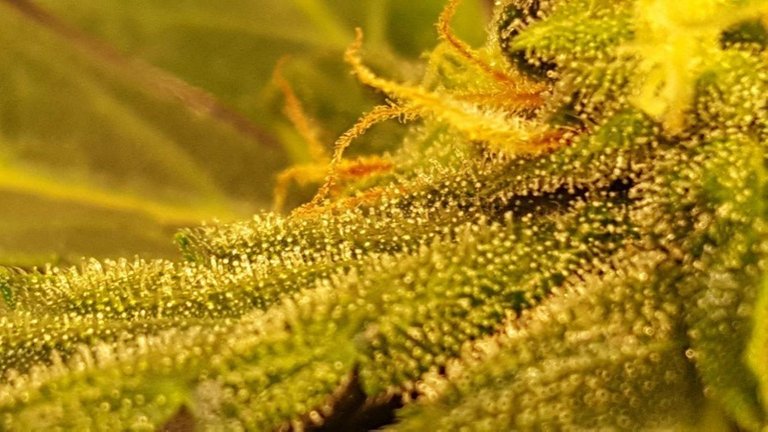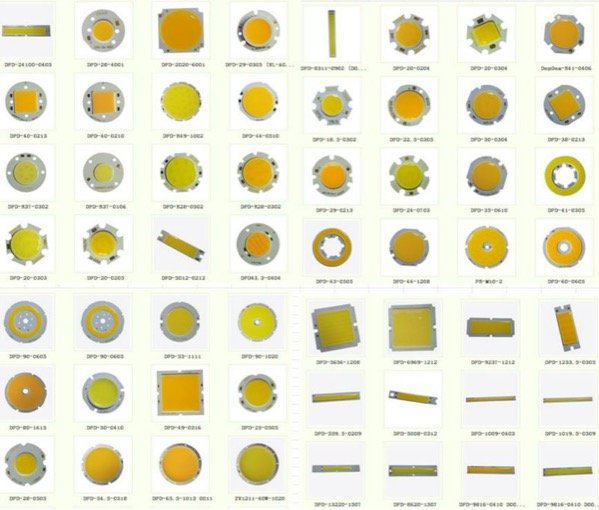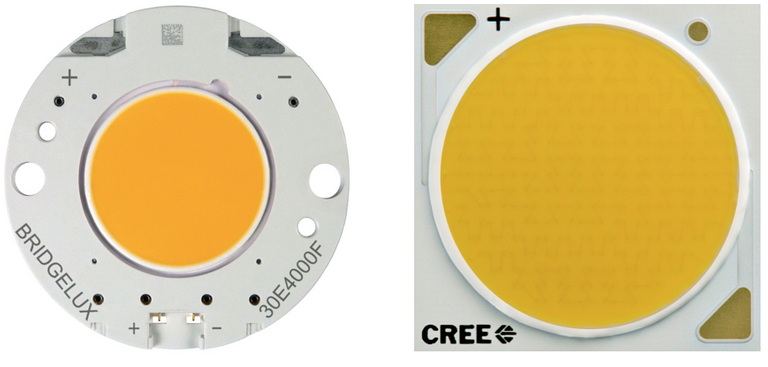Hello Steemers today I'm going to talk about COB LEDs and why I think they are awesome when it comes to indoor Growing. I have currently done 3 grows with a LED COB light that I built using Bridgelux chips and the results were pretty good. The lights I have currently use 320w of power which is 280 less than what I had with my 600w HPS bulb. The light temperature is 3000k which is good for the flowering spectrum and these bridgelux chips have enough blue to keep the stretch down.
First Of All, What are COBs?
LED COB (Chip-on-board) technology is the newest development in the LED Lighting industry that places densely packed diodes(anywhere from 9-100) on a printed circuit board (PCB). These chips have a greatly improved lumen per watt ratio (90-170 lm/w) compared with older led technologies. These new chips are small and densely packed and they offer better cooling efficiency than older tech which should lengthen the overall life of the Chip.
What are the advantages cobs have over HPS?

- The main advantage COBS have over HPS is in energy efficiency. A 1000w HPS bulb will produce around 140 lm/w compared to current generation cobs that produce an average of 155 lm/w. HPS expends much of its energy on infrared light. This infrared light does little in regard to photosynthesis and produces a lot of heat.
Heat efficiency. Cobs produce extremely less heat than their HID counterparts adding to better grow room efficiency by not having to spend so on cooling.
Cobs don’t need a ballast for power. - Light spectrums can be chosen or tailor made for certain stages of growth.
Life span of cobs is anywhere from 50,000-150,000 hrs.
Light Intensity Fading is much lower - DIY is easy for an average person Heatsink+Chip+Driver(and if you get a chip with a molex connector you don’t even need to solder anything)
What are the Disadvantages of COBs?
- The main disadvantage i see with cobs is the lack of uniformity between different chips. There are so many COB producers out there using different chips with different color temperatures driven at different currents it makes it hard to judge the correct distance from the canopy the light should be.
- The back of the hand technique doesn't work with cobs so theres a heightened chance of giving your plants light burn.
- Expensive initial cost.
Which light produces a larger harvest?

Well It is easier to get a large crop with HPS than with COBS. That doesn't mean you cant get big yields with COBs but your growing tactics have to change a bit in order to match or achieve better yields than HPS. For the most part since the night and day temperature difference is less with COBs than HPS plants won't grow as fast as HPS. but if your worried about keeping the length between nodes short this is a huge advantage. One you tuber with his cree CXA 3070 was able to achieve 1.5 grams per watt on his grow.
Which Light Produces a more potent harvest?

HPS is usually the gold standard when it comes to producing a large crop with high potency. But the one thing that is usually agreed upon when it comes to LED grows is that the buds are more potent. COBs are no different. if you choose a cob that has some UV in the spectrum you can get some extremely frosty nugs.
Whats better about COBS than older LEDs
- COB LEDs are Packed Densely so there isn’t the perception of multiple light sources.
- COBs get a better lumen to watt ratio than older technology.
- You can get COBs in normal Color Spectrums ranging from 2700k-6500K instead of the 2 wavelength Red and Blue LEDs.
- It’s easier to spot deficiencies and mold under normal white light than Red Blue.
- Easier to fix easier to build.
- Better Yields.
What are the best COBs on the market?
I believe Bridgelux and CREE are the top 2 Chip makers in respect to COB LED production. CREE is one of the best led manufacturers out there with some of the best technology. Bridgelux also has some high quality tech so if your going to buy a COB look for one with either of these two chips inside. If you are going to build your own the CREE 3070 is a great chip and Bridgelux has the Vero 29 which is what I used for my light. I chose Vero because it has a higher amount of red light in its 3000k chip than the CREE. The Vero 29 also has the advantage of a molex connector so if you don't want to solder anything I would go with the Vero. And Citizen also has some pretty good chips.


Not A Wiring Guy? No Worries!
You can quickly put together an LED grow, using screw-in LED replacement light bulbs! Grab some pre-wired light sockets, a few screw-in LED replacement lamps and you're good to go! :D
Look How Easy It Is! << Link!
I'm Loving LED's for micro growing and can't wait to switch from HPS for flowering in the big tent. :)
Go Be Awesome! :D
good post
Thanks
You really love Cobs don't you lol
Ya they are a lot more energy efficient and I feel like I get a more potent harvest in the end.
I've been looking around and they're kind of expensive. like there was one with CREE chips that I saw that was like 600 dollars
Just build one it's really not that hard. I told u before its just 200$ for the parts for a 320w. that comes out to about 65 cents per watt
Cool post!!! I never even knew there were leds like that.
@originalworks
Peace, Abundance, and Liberty Network (PALnet) Discord Channel. It's a completely public and open space to all members of the Steemit community who voluntarily choose to be there.Congratulations! This post has been upvoted from the communal account, @minnowsupport, by greengrowgringo from the Minnow Support Project. It's a witness project run by aggroed, ausbitbank, teamsteem, theprophet0, someguy123, neoxian, followbtcnews/crimsonclad, and netuoso. The goal is to help Steemit grow by supporting Minnows and creating a social network. Please find us in the
This post has received a 0.63 % upvote from @drotto thanks to: @banjo.
Thanks for the info! I was wondering about these, but was unsure due to the fading of certain LEDS that aren't made for agriculture. Now I'm more confident that these are good choice, thanks again.
Love the post dude!!